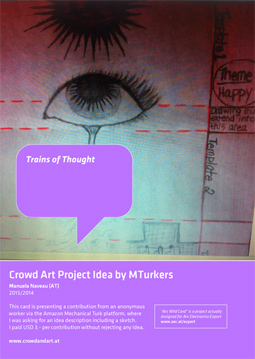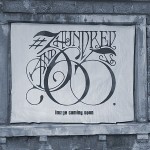 3hundredand65 (2012) is a collaborative online storytelling project that’s raising money to support the Teenage Cancer Trust by inviting contributors to “crowdauthor a graphic novel”. Idea and daily illustration by Dave Kirkwood http://www.3hundredand65.co.uk/
3hundredand65 (2012) is a collaborative online storytelling project that’s raising money to support the Teenage Cancer Trust by inviting contributors to “crowdauthor a graphic novel”. Idea and daily illustration by Dave Kirkwood http://www.3hundredand65.co.uk/
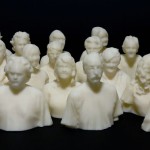 The Open Crowd Project (2012 and ongoing) is a collaborative project by Brian Harper, using 3D scanning and printing technology to create a “crowd” of people printed with 3D printers. http://www.theopencrowdproject.com/
The Open Crowd Project (2012 and ongoing) is a collaborative project by Brian Harper, using 3D scanning and printing technology to create a “crowd” of people printed with 3D printers. http://www.theopencrowdproject.com/
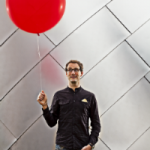 Riley Crane and the DARPA Network Challenge (2009) demonstrated the power of social media and social networks by mobilizing society to find 10 red balloons. During a period ranging from six to nine hours on December 5, 2009, DARPA place 10 large, moored, red weather balloons at hidden locations around the country, and offered a $40,000 prize to anyone, anywhere in the world using any means available to be the first to report the location of all ten. The DARPA Network Challenge was a contest designed to better understand the role that crowdsourcing and social media play in timely communication, and urgent mobilzation and wide-area team building in an adversarial context. In two days our team built a platform based on a networked incentive scheme that was able to effectively search the entire geographic area of the United States, and we found all 10 balloons in 8 hours and fifty-two minutes.
Riley Crane and the DARPA Network Challenge (2009) demonstrated the power of social media and social networks by mobilizing society to find 10 red balloons. During a period ranging from six to nine hours on December 5, 2009, DARPA place 10 large, moored, red weather balloons at hidden locations around the country, and offered a $40,000 prize to anyone, anywhere in the world using any means available to be the first to report the location of all ten. The DARPA Network Challenge was a contest designed to better understand the role that crowdsourcing and social media play in timely communication, and urgent mobilzation and wide-area team building in an adversarial context. In two days our team built a platform based on a networked incentive scheme that was able to effectively search the entire geographic area of the United States, and we found all 10 balloons in 8 hours and fifty-two minutes.
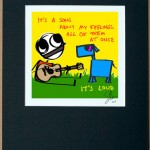 explodingdog (2001 and ongoing) by Sam Brown (US) http://explodingdog.com/ is building the bases for a lot of cowdsourced statements, that are becoming visualized by an illustrator.
explodingdog (2001 and ongoing) by Sam Brown (US) http://explodingdog.com/ is building the bases for a lot of cowdsourced statements, that are becoming visualized by an illustrator.
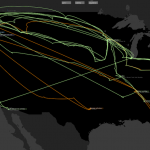 Trash Track – Visualisierung der Wege des Hausmülls; Das MIT´s senseable city lab (US), geleitet von Carlo Ratti (IT), hat ein Projekt initiert, um die (auch umständlichen) Wege des Hausmülls zu visualisieren. Die Bevölkerung in Boston half mit und mehr als 3000 Hausmüll-Gegenstände bekamen Sensoren und konnten so auf ihrem Weg zur Endentsorgungsstelle verfolgt werden. http://senseable.mit.edu/trashtrack/
Trash Track – Visualisierung der Wege des Hausmülls; Das MIT´s senseable city lab (US), geleitet von Carlo Ratti (IT), hat ein Projekt initiert, um die (auch umständlichen) Wege des Hausmülls zu visualisieren. Die Bevölkerung in Boston half mit und mehr als 3000 Hausmüll-Gegenstände bekamen Sensoren und konnten so auf ihrem Weg zur Endentsorgungsstelle verfolgt werden. http://senseable.mit.edu/trashtrack/
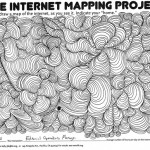 The Internet Mapping Project (2009) by Kevin Kelley US) http://www.kk.org/ct2/2009/06/the-internet-mapping-project.php, who is founding executive editor of Wired magazine (which was conceived by Louis Rosetto and Jane Metcalf).
The Internet Mapping Project (2009) by Kevin Kelley US) http://www.kk.org/ct2/2009/06/the-internet-mapping-project.php, who is founding executive editor of Wired magazine (which was conceived by Louis Rosetto and Jane Metcalf).
-
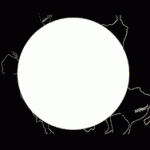 The World Map Archive (since 2013) by Benjamin Pollach (DE) http://worldmaparchive.com/ The World Map Archive is an archive for first-try world mappings.
The World Map Archive (since 2013) by Benjamin Pollach (DE) http://worldmaparchive.com/ The World Map Archive is an archive for first-try world mappings.
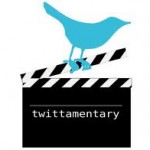 Twittamentary (2010 and ongoing) by Tan Siok Siok (SG) is a film , that looks at how lives connect and intersect within the Twitter community as the real-time web accelerates serendipity. Bonds are forged as a result of unexpected encounters between strangers as they share moments of their lives in real time. The stories and contributions to the film have been crowdsourced.
Twittamentary (2010 and ongoing) by Tan Siok Siok (SG) is a film , that looks at how lives connect and intersect within the Twitter community as the real-time web accelerates serendipity. Bonds are forged as a result of unexpected encounters between strangers as they share moments of their lives in real time. The stories and contributions to the film have been crowdsourced.
- reCAPTCHA ist ein CAPTCHA-Dienst von Google, um Bücher zu digitalisieren. Der Informatiker Luis von Ahn hat dazu ein System namens reCAPTCHA programmiert, das bei der Buch-Digitalisierung eingescannte Wörter, die die Texterkennungssoftware nicht erkennt, durch die Eingabe von CAPTCHAs optimiert. Auf jedem CAPTCHA sind zwei Wörter abgebildet: Eines, das dem System bereits bekannt und bestätigt ist, das andere ist ein unerkanntes Wort aus einem Buch.
http://www.google.com/recaptcha
 Transcribe Bentham (2010 and ongoing) by University College London http://www.ucl.ac.uk/transcribe-bentham/. Thousands of unpublished pages of Jeremy Bentham’s manuscripts have been ready for transcription with a crowdsourcing program.
Transcribe Bentham (2010 and ongoing) by University College London http://www.ucl.ac.uk/transcribe-bentham/. Thousands of unpublished pages of Jeremy Bentham’s manuscripts have been ready for transcription with a crowdsourcing program.
 Project Gutenberg http://www.gutenberg.org/ offers over 42,000 free ebooks: to choose among free epub books, free kindle books, to download them or to read them online. They digitized and diligently proofread them with the help of thousands of volunteers.
Project Gutenberg http://www.gutenberg.org/ offers over 42,000 free ebooks: to choose among free epub books, free kindle books, to download them or to read them online. They digitized and diligently proofread them with the help of thousands of volunteers.
- GARMZ (2009 – 2013) Garmz.com was an austrian start-up, which presented, produced and merchandised Fashin Design of young designers via an online voting system.
- Dissertation Guttenberg
- Die Hexe von Portobello
- Halsey Burgund and his work „Scapes“
- Electric Sheep (2010)
- Stencilboard (community is contributing to archive of stencils)http://www.stencilboard.at/
- Visulaisierung von Crowd dynamics (Verkehr)http://liftlab.com/think/nova/2010/04/12/crowd-dynamics-determined-by-more-than-physical-constraints/
- The Mongoliad http://mongoliad.com/
Insbesonder gemeinfreie Bücher (abgelaufenes Copyright) werden über diese Website gemeinschaftlich digitalisiert und sind danach frei zum download für verschiedenen Lesegeräte zur Verfügung gestellt. Für die Qualitätsicherung, also das Lektorat kommt das Konzept der “Distributed Proofreaders” zum Einsatz.
Junge Designer schicken ihre Entwürfe ein, diese werden ohne weitere Vorauswahl auf die Website gestellt. Die über Facebook oder Twitter betreute Community stimmt ab. Wenn sich ein Produkt durchsetzt, übernimmt Garmz das Prototyping und kümmert sich um Stoffe, Produktion und Verkauf – die Modeschöpfer müssen kein Geld aufbringen weil nur geliefert wird, wenn vorher bestellt wird.
Ein Wiki für die kollaborative Dokumentation der Plagiate – jeder ist eingeladen, hier mitzuarbeiten.
http://de.guttenplag.wikia.com/wiki/GuttenPlag_Wiki
Künstler: Paulo Coelho (BR)
Art der Partizipation: Videobeiträge aus Sicht des Fans
Zeitrahmen: 2010
Der brasilianische Autor Paulo Coelho ist extrem aktiv im Web 2.0 und sucht den permanenten Kontakt zu seinen Fans und Lesern. Unter diesem Gesichtspunkt war es nur konsequent, dass er im Jahr 2008 sein Werk “Die Hexe von Portobello” durch seine große Fangemeinde verfilmen ließ. Das Buch besteht aus 15 Einzelteilen, die von 15 verschiedenen Regisseuren verfilmt werden konnten. Der Film wurde dann auf mehreren Filmfestivals vorgestellt.
http://www.socialnetworkstrategien.de/2008/06/paulo-coelho-zeigt-wie-man-in-socialnetworks-agiert
http://www.decordova.org/art/exhibitions/current/scapes.html
Software Art (crowd worked on code) http://de.wikipedia.org/wiki/Electric_Sheep and http://www.youtube.com/watch?v=P3j3Sx5Hcpo
Archiv Projekte / Sammlungen
Musik- und Videoprojekte
¨ Eine Sammlung von 10 Musikvideoprojekten, die mittels crowdsourcing entstanden sind http://mashable.com/2010/07/25/crowdsourced-music-videos/
¨ OK Go http://www.okgo.net/ Sind berühmt geworden wegen Ihren Communityprojekt Tanzprojekt „A Million Ways“
Es ist ein Experiment: Nicht ein Einzelautor erzählt, sondern eine Community, die über das Web miteinander kommuniziert und an einem Fortsetzungsroman arbeitet. “The Mongoliad” nennt sich das Online-Werk von Stephenson und seinen Co-Schreibern. Ein Mittelalterroman, in dessen Zentrum vergessene europäische Kampftechniken stehen. Schriftsteller und Leser kreieren gemeinsam eine fiktive interaktive Welt auf der eigens dafür gegründeten E-Publishing-Plattform “Subutai”.
Das kollaborative Schreiben braucht Organisation: Es gibt ein Team von sieben Haupt-Autoren und viele andere Leute, die als Experten immer wieder Input liefern und an dem Fortsetzungsroman mitschreiben. Ein Team hat ein Auge auf den roten Faden und checkt, dass die verschiedenen Handlungsstränge sich nicht verheddern.

